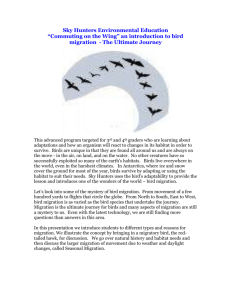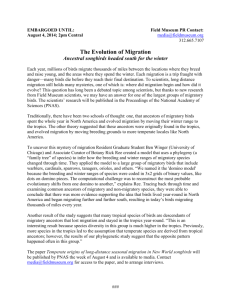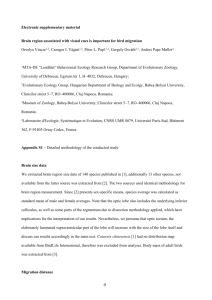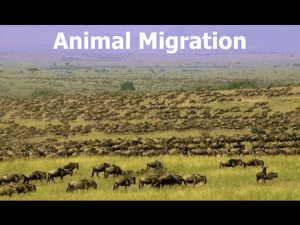Bird Migration
advertisement
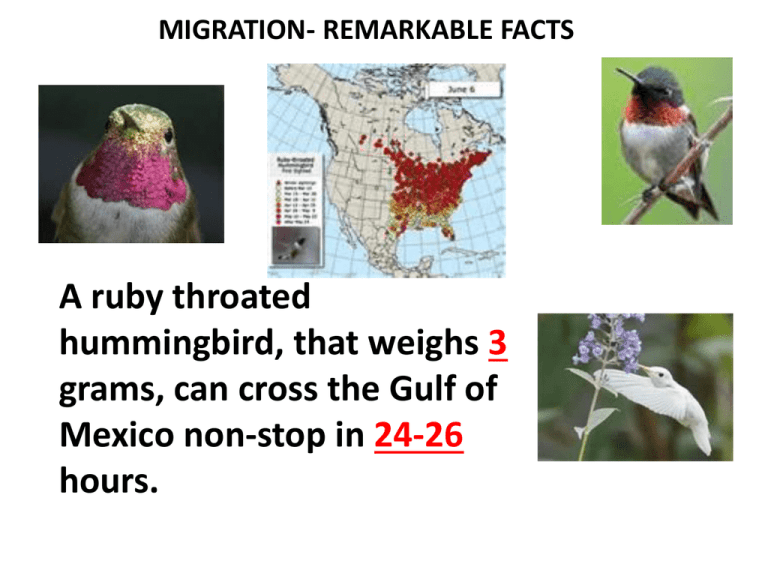
MIGRATION- REMARKABLE FACTS A ruby throated hummingbird, that weighs 3 grams, can cross the Gulf of Mexico non-stop in 24-26 hours. MIGRATION- REMARKABLE FACTS Bar-headed geese cross the Himalaya Mountains traveling as high as 28,000 feet. MIGRATION-REMARKABLE FACTS It takes the blackpoll warbler 80 to 90 hours to migrate nonstop across the Atlantic Ocean to South America. This is equivalent to a human running a 4 minute mile nonstop for 80 hours. MIGRATION-REMARKABLE FACTS The Arctic tern flies from the Arctic to the Antarctic and back, a total of 49,700 miles for the round trip. In its lifetime, an individual will fly 1.5 million miles or the equivalent to 60 trips around earth or 3 trips to the moon. PREPARATION FOR MIGRATION 1. Hyperphagia is the term that refers to the massive intake of calories resulting in the build up of fat. Prior to migration, birds can increase their body fat by 40 to 100%. Some can increase their body fat at the rate of 10% a day. 40% body fat fuels them for around 100 hours and 1,500 miles. MIGRATION PREPARATION Just prior to migration, birds go through a period of hyperactivity known as migration restlessness, in which they stop feeding. PHYSIOLOGY OF MIGRATION 2. The organizing of internal organs involves the heart and flight muscles growing while the digestive system shrinks. Some birds will reabsorb their digestive system if they use up their fat and muscle. MIGRATION 4.For orientation, departure, and navigation, birds use visual marks, the position of the sun and stars, geomagnetism to start and complete their migration. MIGRATION Birds use their sun compass, an internal clock which indicates the position of the sun in relationship to time. This is innate. Birds use their star compass for night orienting and fixing on constellations. This is NOT genetic but a learned behavior. Internally, a bird’s head contains magnetite (Fe O4) crystals that allow them to “see” the earth’s magnetic field. MIGRATION 5.It is the hypothalmus of a bird’s brain that initiates appetite, while stimulation of the pineal gland causes migration restlessness. HUMAN OBSTACLES TO MIGRATION Loss of stop over habitat-This is why rivers like the San Pedro are so important to migrating birds. Wind turbines account for bird deaths ranging from 10,00040,0000 per year. HUMAN OBSTACLES TO MIGRATION Tall glass windowed buildings result in bird deaths ranging from 100 million to 1 billion per year. Power lines and power poles account for 130-174 million bird deaths annually. HUMAN OBSTACLES TO MIGRATION CATS –Kill over 500 million birds per year in North America alone!!! HUMAN OBSTACLES TO MIGRATION On a global scale, over 5 billion pounds of conventional pesticides are used annually. 20% or 1.2 billion pounds are used annually in the United States. Roughly 672 million birds are exposed annually to pesticides on U. S. agricultural lands, 10%- or 67 million –are killed. SWAINSON’S HAWK + PESTICIDES In 1995, the pesticide monocrotophos, sprayed to kill grasshoppers, was responsible for the deaths of at least 20,000 Swainson’s Hawks in Argentina.
